.
21.06.2014

ESA astronaut Alexander Gerst thoroughly checking a newly arrived American spacesuit on the International Space Station.
.
Three weeks into ESA astronaut Alexander Gerst’s Blue Dot mission on the International Space Station and the new arrival is now spending more time on scientific research in the microgravity laboratory.
Alexander has worked on controlled fires in space and continuously monitored his sleep patterns, at the same time as making sure the orbital outpost is working at full capacity.
Apart from continuing the long-term studies on eyes and headaches in space, Alexander recorded his temperature and hormones over 36 hours to understand his sleep patterns.
Astronauts on the Station witness 16 sunrises and sunsets each day – whereas on Earth our bodies rely on sunlight to kick-start hormone production that make us sleepy or wake us up.
Researchers are interested to see how the unique 90-minute days influence sleep. Aside from making sure astronauts feel awake at critical moments, this research in space allows sleep specialists to test theories that they couldn’t anywhere else.
.
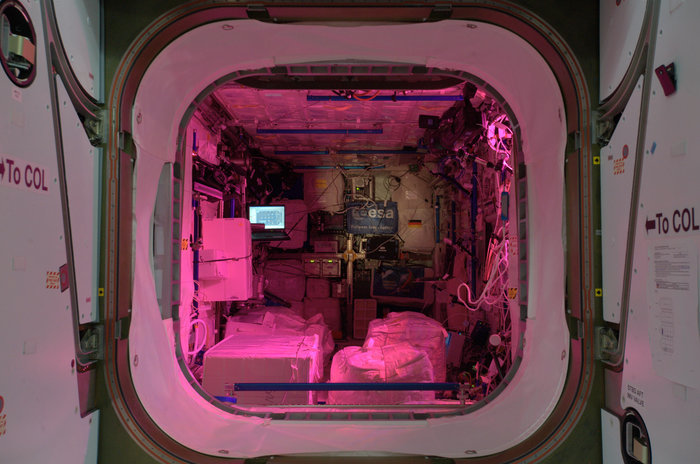
Europe’s laboratory on the International Space Station. Since 2008 the module has offered a unique workstation for researchers to investigate phenomenon in microgravity.
Over 110 ESA-led experiments involving some 500 scientists have been conducted, spanning fluid physics, material sciences, radiation physics, the Sun, the human body, biology and astrobiology.
.
Alexander acted as a weightless firestarter and firefighter this week when he ignited small samples of fuels safely contained in ESA’s glovebox to see how they burn in space. He volunteered as a fireman before becoming an astronaut, so the experiment was in good hands.
This research will improve computer models for fire detectors and extinguishers, both in space and on Earth. He explained the experiment via Twitter: “Burning things in space for better fire safety on Earth.”
Elsewhere, Alexander took samples of his blood and saliva and collected data on his eyes, his skin and his body so researchers can understand how astronauts react to weightlessness.
Other notable experiments included the harvesting of space-grown salads – unfortunately for the astronauts, they are not allowed to eat them.
Spacewalk
Yesterday, cosmonauts Oleg Armetyev and Alexander Skvortsov spent over six hours working outside the Station to install an antenna, take samples and move experiments. Meanwhile the four astronauts inside continued their science activities.
Earlier, Alexander thoroughly checked a newly arrived US spacesuit. Before being declared ready for use, he had to make sure it had survived its climb into space.
Alexander even had time this week for educational activities for Earth Guardian, inspiring children to observe geographical features such as oceans, rivers, landscapes, mountains and forests in their areas during the summer holidays.
.
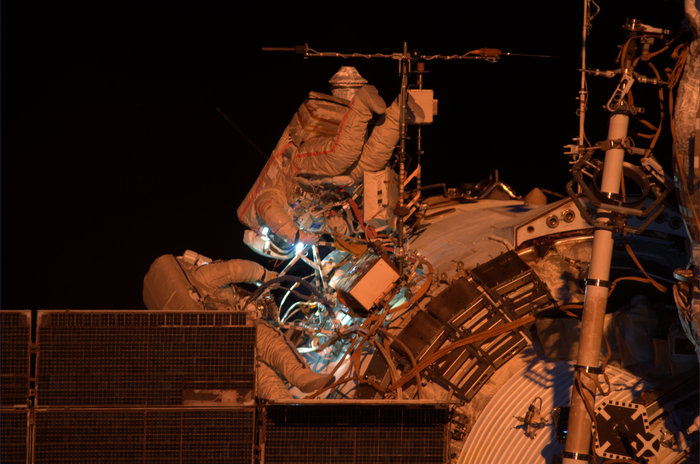
Russian cosmonauts Alexander Skvortzov and Oleg Artemyev spent over six hours working outside the International Space Station on 19 June 2014. This picture was taken by ESA astronaut Alexander Gerst from inside the orbital outpost.
Quelle: ESA
.
Update: 28.06.2014
.
World Cup Wager: U.S. Astronauts Shave Heads After Loss
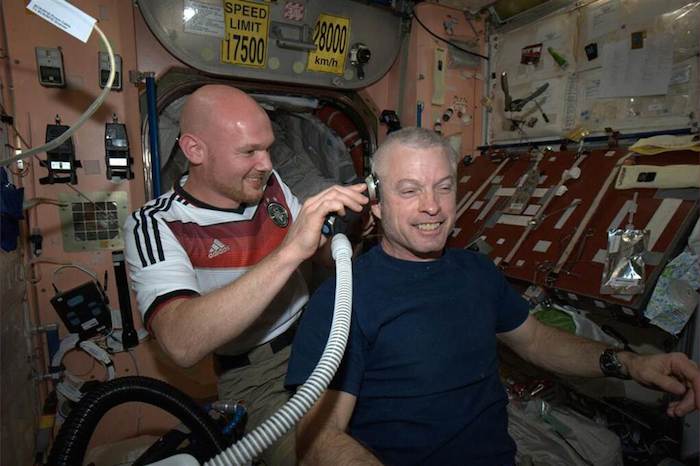
American astronauts on the International Space Station, Steve Swanson, above, and Reid Wiseman, followed through on their World Cup bet, allowing their German crewmate Alexander Gerst to shave their heads to match Gerst's bald pate following the U.S. team's 1-0 loss to Germany on Thursday. Gerst posted the photo below to Twitter, saying "Mission accomplished."
.
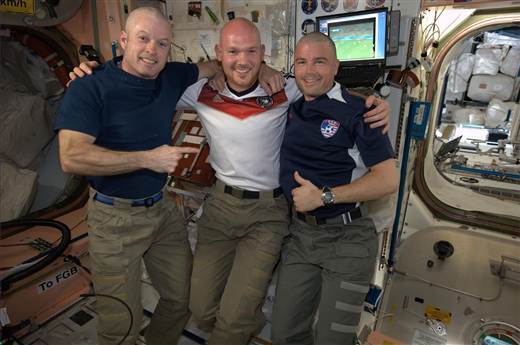
U.S. astronauts Steve Swanson and Reid Wiseman, right, show off their freshly-shaven heads after Gerst shaved them aboard the International Space Station
Quelle: NBC
.
Update: 2.07.2014
.
SPOT THE SPACE STATION LOOKING AT YOU

ESA astronaut Alexander Gerst and five astronauts from America and Russia are flying on the International Space Station 400 km above us – but did you know they are sharing live views of our planet and you can even see their home at night?
Circling Earth at 28 800 km/h, it takes only 90 minutes to complete a circuit of our planet – while cameras transmit the incredible view for everybody to see.
Find out where the Station is and enjoy the same views as the astronauts by visiting ESA’s Space Station tracker. The orbital outpost flies over the planet between latitudes 52ºN/S, reaching from the tip of South America to the UK.
As it skims overhead, it looks like a bright star travelling smoothly across the heavens. Unlike aircraft, though, its light holds steady and it will always appear from the west and head eastwards.
ESA’s app for Apple smartphones and tablets keeps you updated on the trajectories of all ESA satellites, including the Space Station. Alternatively go to NASA's Spot the Station website and enter your city to receive alerts of when it next flies over your area.
Share the view
Taking a picture as the astronauts streak through the night sky is not difficult. Keep your camera steady on a tripod and make sure your exposure time is more than 30 seconds. If all goes well, you should capture a white streak that is the Station flying at 23 times the speed of sound.
Make the picture more interesting by framing a landmark in the foreground and share your creation with the world. Tweet the image with the hashtag #SpotTheStation with the location in brackets such as {Berlin, Germany} and your image will automatically be added to an interactive map.
Spot the Station is a joint project by NASA, Esri, the Canadian Centre of Geographic Sciences and Alexander’s crewmate Reid Wiseman. The locations and images will be collected throughout their mission until Alexander, Reid and commander Maxim Suraev return to Earth in November.
Get your camera ready, look up and hope for cloudless nights.
Quelle: ESA
.
All-Tag von Alexander Gerst in Fotos
.

.
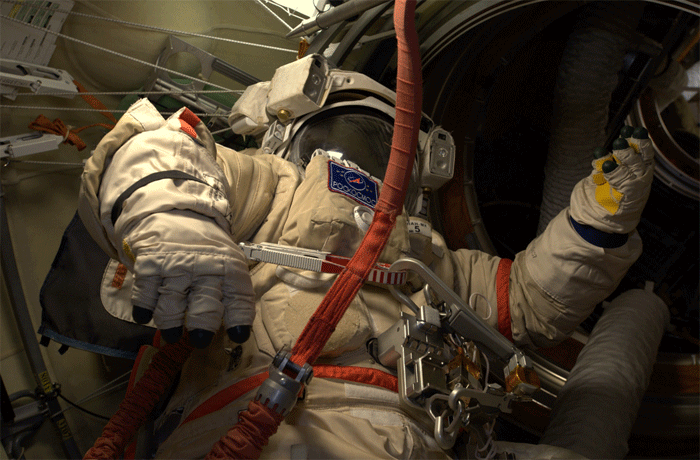
.
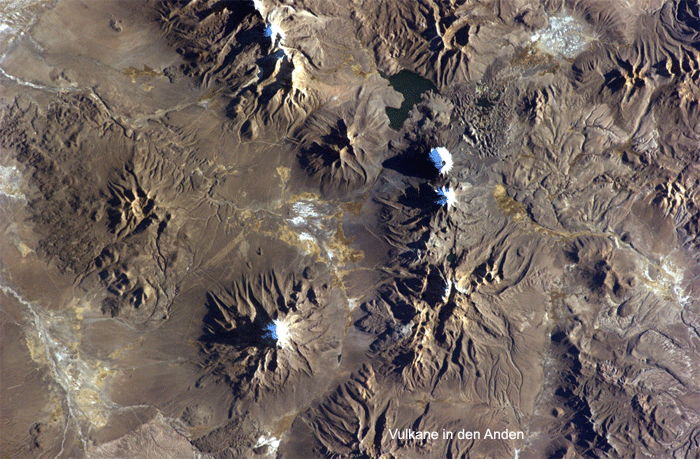
.
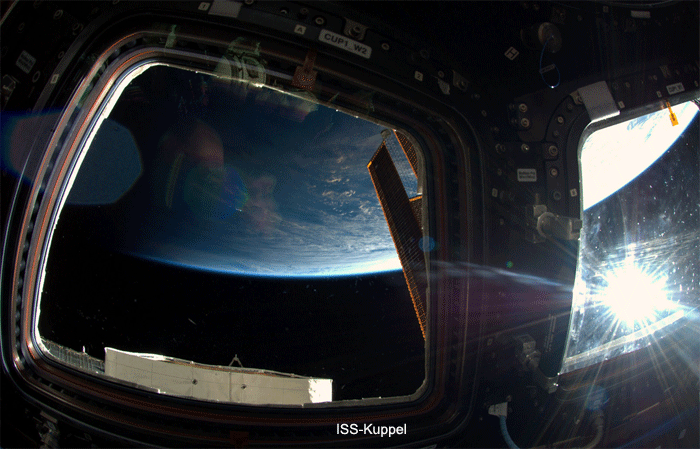
.
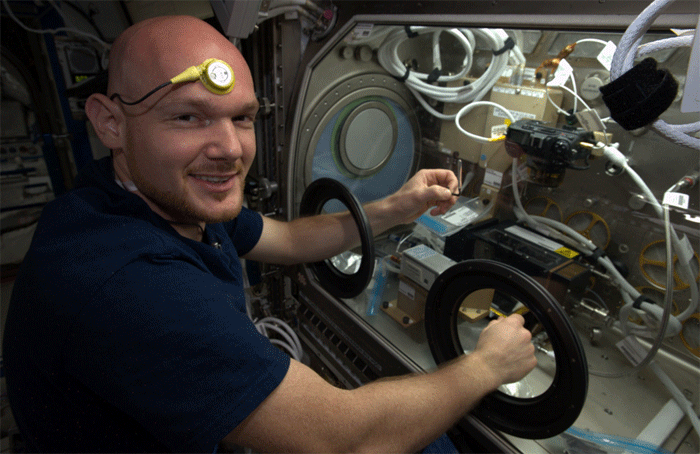
.
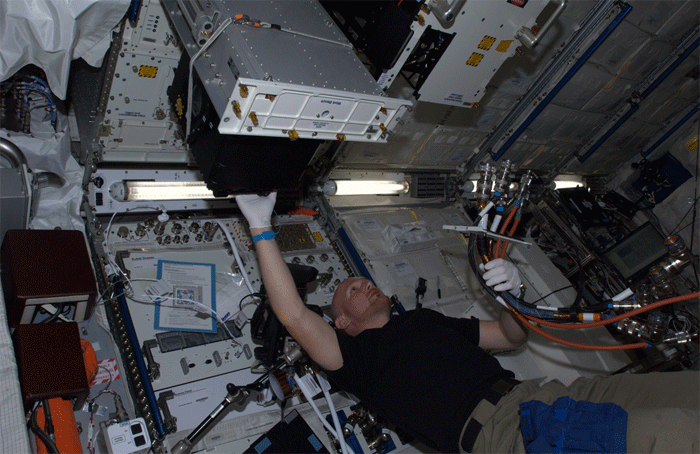
.
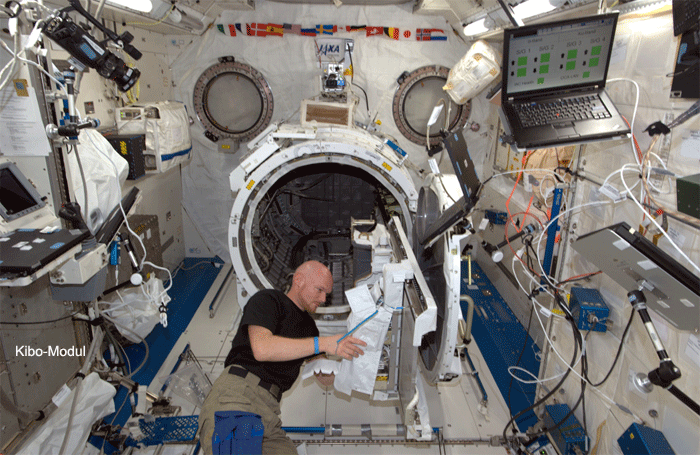
.
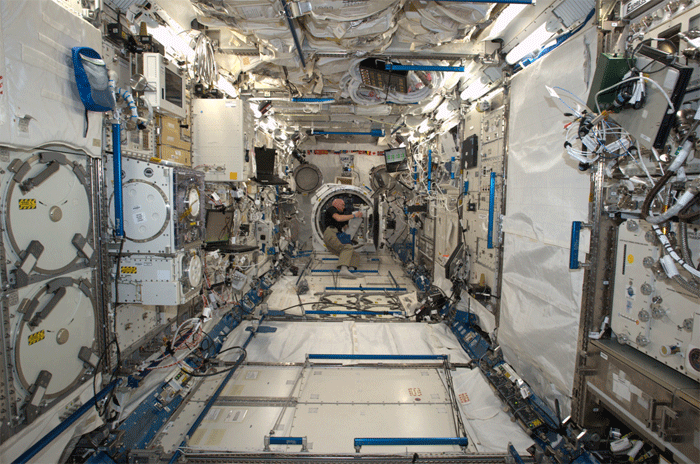
Quelle: ESA
.
Update: 7.07.2014
.
Alexander Gerst seit 39 Tagen unser Botschafter im All
.
Seit 36 Tagen umkreist der deutsche ESA-Astronaut Alexander Gerst nun an Bord der Internationalen Raumstation ISS die Erde - den kleinen blauen Punkt, der dem 38 Jahre alten Geophysiker so sehr am Herzen liegt, dass er seiner ISS-Mission "Blue Dot" sogar ihren Namen gegeben hat.
Die Bodencrew im Columbus-Kontrollzentrum beim Deutschen Zentrum für Luft- und Raumfahrt (DLR) in Oberpfaffenhofen ist begeistert vom jüngsten Teammitglied der aktuellen ISS-Mission: "Alexander hat sich sehr gut an sein Leben im All gewöhnt und reagiert sehr professionell auf unsere Anweisungen. Astronauten sind schwer beschäftigt und haben gleichzeitig viele Aufgaben zu erfüllen", schreiben die Missionsmanager in ihrer Blogpost am 2. Juli.
Zwischen Experimenten, Pflege und Wartung der Raumstation, dem täglichen Fitnesstraining und den Aktivitäten als "Botschafter" blieb in der vergangenen Woche noch ein wenig Zeit für eine unorthodoxe Wette - die Alexander Gerst gewonnen hat; weil die deutsche Fußballnationalmannschaft sich mit einem 2:1 knapp gegen die Nationalelf aus den USA durchgesetzt hat und Gerst seinen Crewkollegen Steve Swanson und Reid Wiseman mit dem elektronischen Haarschneider von der ISS einen neuen "aerodynamischeren" Haarschnitt kreieren durfte.
Doch glücklicherweise sehen sich die drei Astronauten jetzt nicht zum Verwechseln ähnlich. Und so hat der "echte" Alexander Gerst am 30. Juni gleich zwei besondere Botschaften von der Raumstation zur Erde geschickt: Er gratulierte dem 17-jährigen Schüler Talha Evran aus Köln, der sich für Flüchtlingskinder in Deutschland einsetzt und deshalb in der Frankfurter Paulskirche zum Unicef-Botschafter des Jahres 2014 gekürt worden ist. Und er richtete sich persönlich an die knapp 650 Teilnehmer des 64. Lindauer Nobelpreisträgertreffens, das Alexander Gerst selbst als Gast vor einem Jahr besucht hatte.
An Bord der ISS ist Alexander Gerst selbst Wissenschaftler und Ingenieur: In der letzten Woche hat er unter anderem die FASES-Anlage aus ihrer Vorrichtung im europäischen Columbus-Labor der ISS ausgebaut und das seit 2008 auf der ISS laufende Experiment Geoflow neu installiert. Das Physik-Experiment befasst sich mit den Strömungsprozessen im Inneren unserer Erde und "schaltet" dabei die Schwerkraft aus. Das aus Deutschland stammende Haut-Experiment SKIN-B hat der 38-Jährige ebenso fortgesetzt wie seine Untersuchungen zu Kopfschmerzen und Augengesundheit im All. Die "Occular Health"-Studie der NASA haben Gerst, Wiseman und Swanson in der vergangenen Woche mit letzten Messungen abgeschlossen. Im Fokus standen dabei Datenreihen zum Augenhintergrund und zum Augeninnendruck.
Zudem hat Alexander Gerst im amerikanischen Harmony-Modul am "Capillary Flow Experiment" (CFE) der NASA gearbeitet: CFE ist eine Experimentserie zum Verhalten von Flüssigkeiten in Schwerelosigkeit. Die Ergebnisse sollen dazu dienen, bessere Wasser- und Treibstoffsysteme für Raumfahrzeuge zu entwickeln. Seine handwerklichen Fähigkeiten konnte der deutsche ESA-Astronaut unter anderem bei der Kontrolle und Reparatur einer Wasserpumpe im Columbus-Modul unter Beweis stellen. Gerst hat daneben "Kubik-3", einen kleinen Inkubator für automatisch ablaufende biologische Experimente in Schwerelosigkeit, aufgebaut. Im amerikanischen Tranquility-Knoten der Raumstation hat der Deutsche zusammen mit ISS-Kommandant Steve Swanson das Kohlendioxid-Aggregat kontrolliert und gereinigt.
.
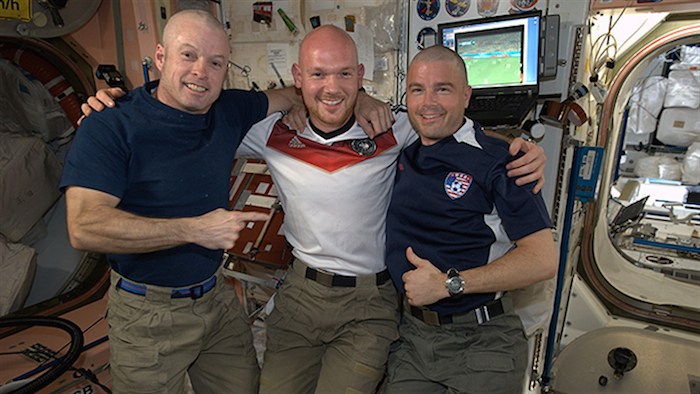
Alexander freut sich schon auf Halbfinale Brasilien-Deutschland
.
Quelle: DLR
.
Update: 15.07.2014
.
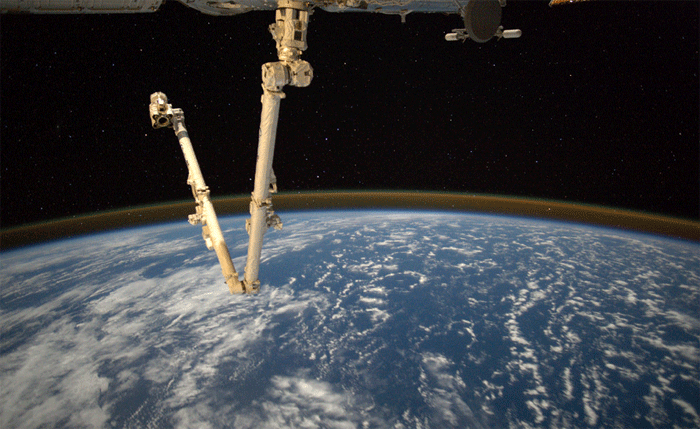
Morgen werden wir mit diesem Roboterarm das Cygnus Raumschiff einfangen. Steve ist an den Joysticks, ich schicke Kommandos ans Raumschiff.
.

Wer hat hier von Photoshop gesprochen? Das ist Weltklasse-Weltraum-Näherei ....
.

Have a great 14 July, my friends in France and at ESA headquarters.
Bon 14 juillet à mes amis francais!
.
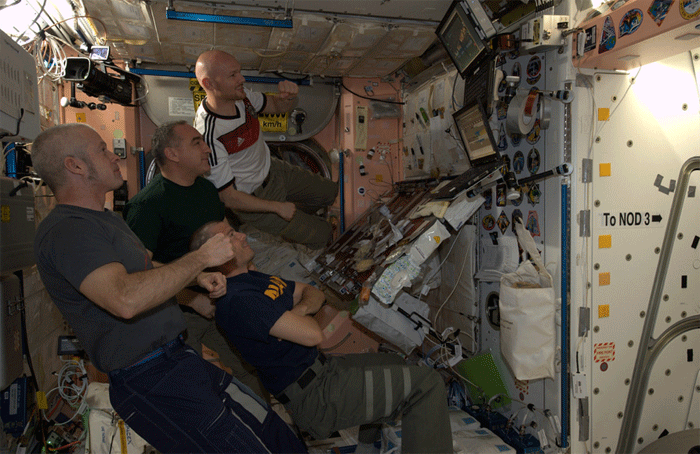
Spannendes Finale mit 28.000 km/h auf der Raumstation. GO die Mannschaft. SCHLAAAAAND!
.
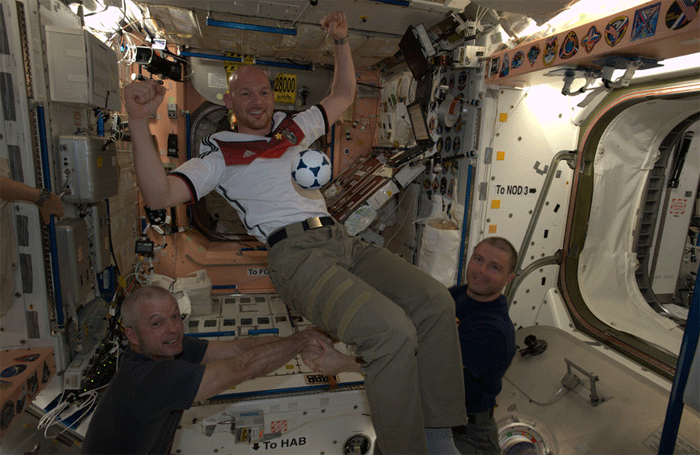
Just like our German team I have fantastic support from my crew. Congrats from the International Space Station to the world champion, and thanks for a great game!
.
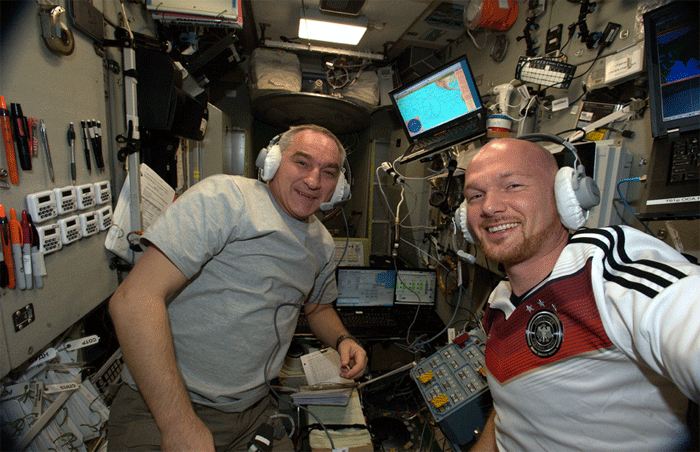
My crew mate Sasha Skvortzov and I will be watching over the arrival of ESA's cargo vehicle ATV-5 on this command post.
Bereiten die #ISS auf die Ankunft des Europäischen Raumtransporters ATV vor.
Quelle: DLR
.
Update: 3.08.2014
.
Crew Studies Flames in Space While ATV-5 Coasts to Station
.
The six-member crew of Expedition 40 continued more combustion science and cargo transfers Thursday. Meanwhile, Europe’s Automated Transfer Vehicle (ATV-5) is in its second day on orbit slowly catching up to the International Space Station.
All week long astronauts Reid Wiseman and Alexander Gerst have traded days working on the long-running combustion experiment Burning and Suppression of Solids (BASS-II). It was Wiseman’s turn Thursday to set up the experiment and observe flames, their shape and length of burn time in space. The investigation takes place inside the Destiny laboratory’s Microgravity Science Glovebox while scientists on the ground observe the flames on downlink video.
BASS-II observes the characteristics of flames using different fuel samples and tests the hypothesis that some materials may burn longer with the flames spreading faster in space. Results may allow researchers to design safer, less-flammable spacecraft materials.
Gerst took part in a demonstration experiment for the European Space Agency’s (ESA) Flying Classroom program. The ESA astronaut from Germany videotaped the educational investigation of basic fluid physics for the Marangoni Convection experiment.
Commander Steve Swanson worked inside the berthed Cygnus commercial cargo craft transferring cargo to and from the Harmony node. Swanson also participated in a study investigating the possible long-term risk of atherosclerosis in astronauts. The experiment named Cardio Ox analyzes a crew member’s blood and urine samples including Ultrasound scans of carotid and brachial arteries before, during and after a mission.
On the Russian side of the orbital laboratory, the three cosmonauts, including two veteran station residents, worked on their complement of science and station upkeep activities.
Upcoming commander Max Suraev was back at work transferring cargo from the new ISS Progress 56 (56P) resupply ship attached to the Pirs docking compartment. He also continued updating the station’s inventory management system to ensure his crew mates and ground controllers can locate the stowed supplies, food and gear delivered aboard the 56P.
Past station commander and current Flight Engineer Alexander Skvortsov continued the fan replacement work he started earlier in the week. He swapped the old fans with new low noise units throughout the space station’s Russian modules.
Flight Engineer and first timer space-flyer Oleg Artemyev worked in the Russian segment on various science and maintenance activities.
ESA’s fifth and final ATV-5 is coasting to the International Space Station destined for an August 12 docking to the Zvezda service module’s aft port at 9:34 a.m. EDT. Dubbed the “Georges Lemaître” for the 20th century Belgian astronomer, the ATV-5 is taking the long route to the station so European flight controllers can test new rendezvous sensors. Two tests of the ATV-5’s systems for ultimate collision avoidance with the station will take place Friday.
.
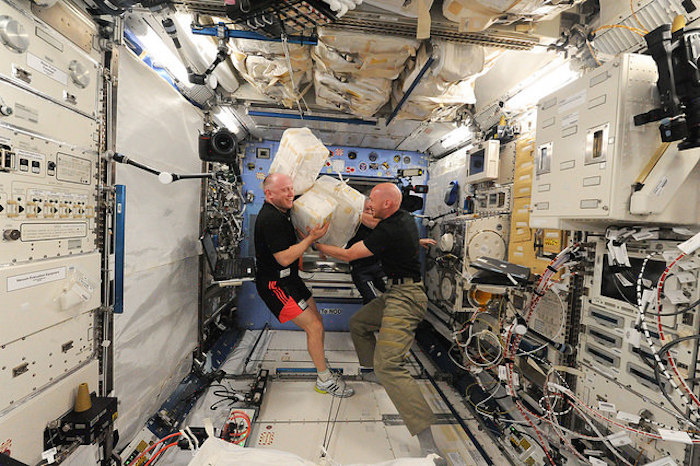
Cosmonaut Oleg Artemyev and German astronaut Alexander Gerst work inside the Kibo laboratory.
Quelle: NASA
.
Update: 10.08.2014
.
Alexander Gerst
Hätte nie gedacht, daß ich einmal mitten durch eine #Aurora fliegen würde
.
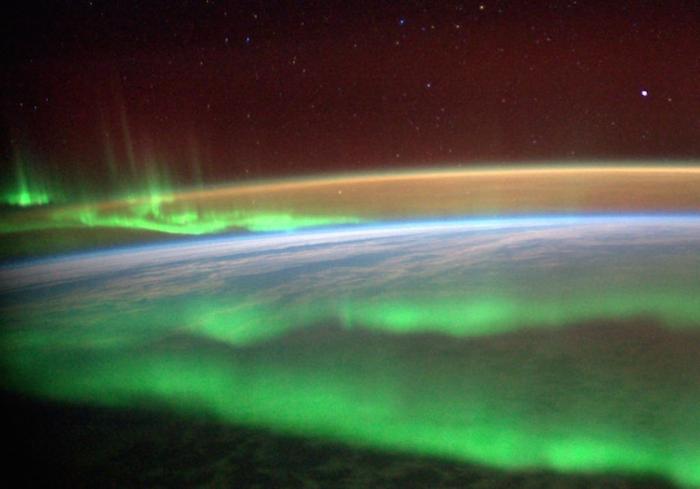
.

Quelle: ESA
.
Update: 2.09.2014
.
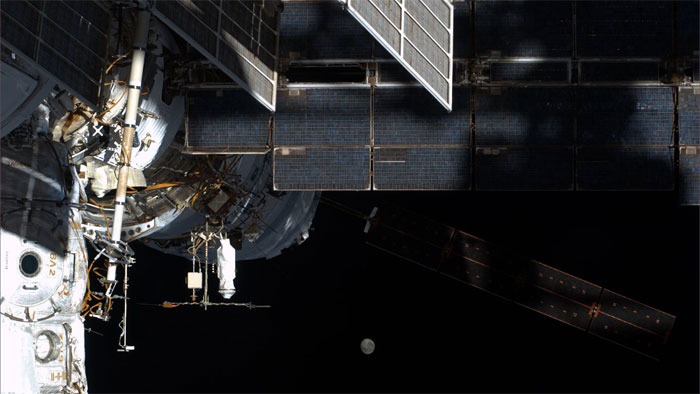
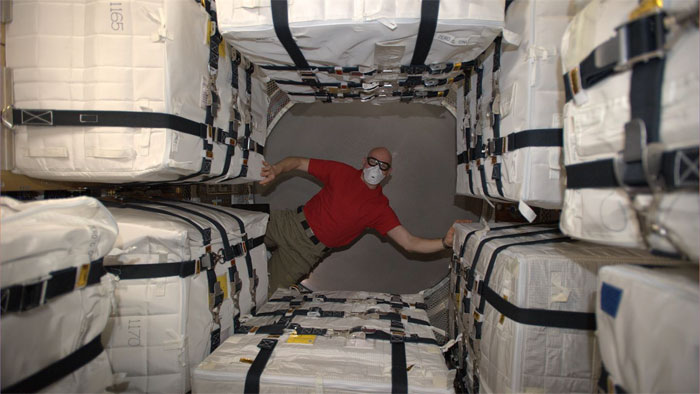
ESA astronaut Alexander Gerst inside ATV Georges Lemaitre for the first time on orbit after hatch opening.
Alexander wears a facemask to protect against inhaling any fine particles of dust or debris that might have shaken lose at launch. One of first things the crew does is install fans and air cleaners to run for several hours inside ATV.
The fifth and last Automated Transfer Vehicle docked with the International Space Station a day earlier on 12 August 2014.
ATV-5 delivers 6.6 tonnes of supplies to the ISS including food, water, fuel, clothes and experiment hardware.
.
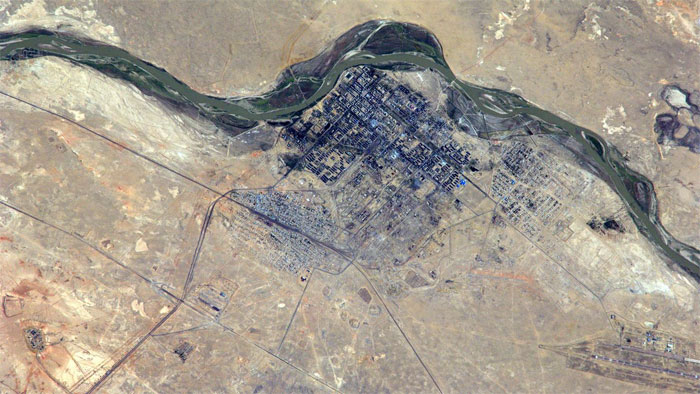
Blick auf Baikonur
.
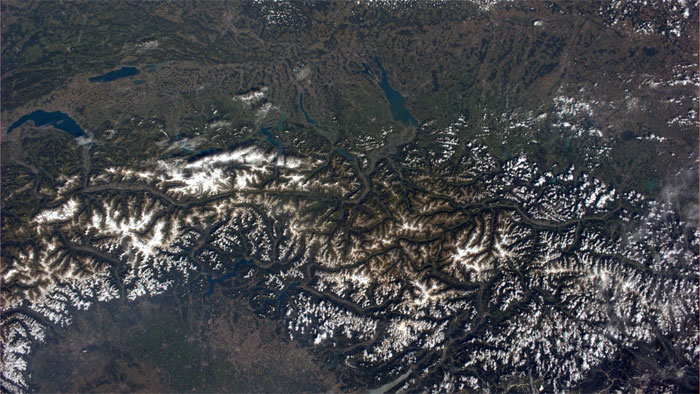
Blick auf die Alpen und Bodensee
Quelle: ESA
.
Update: 3.09.2014
.
Interview mit Alexander Gerst für deutsche Medien / Frams von NASA-Video
.
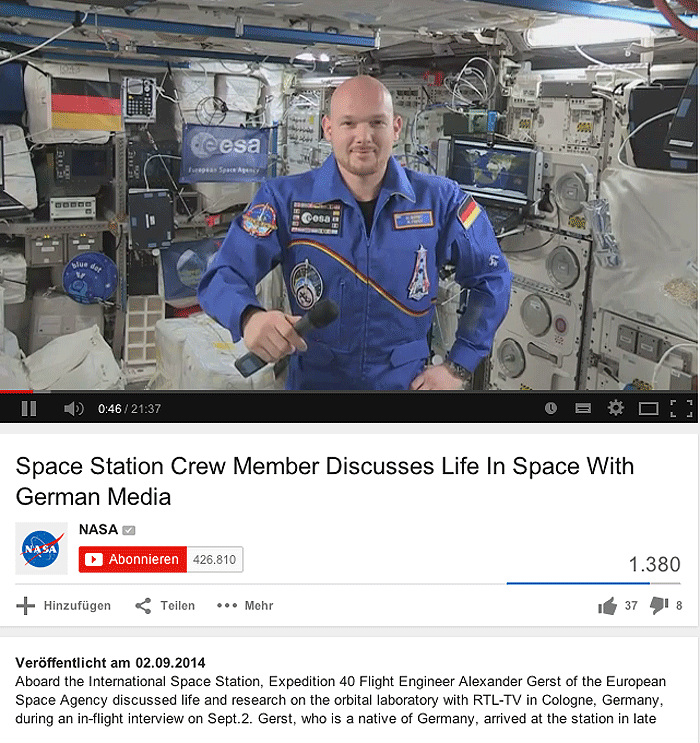
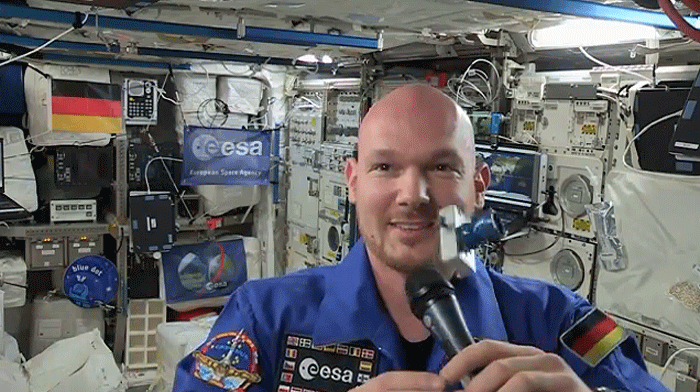

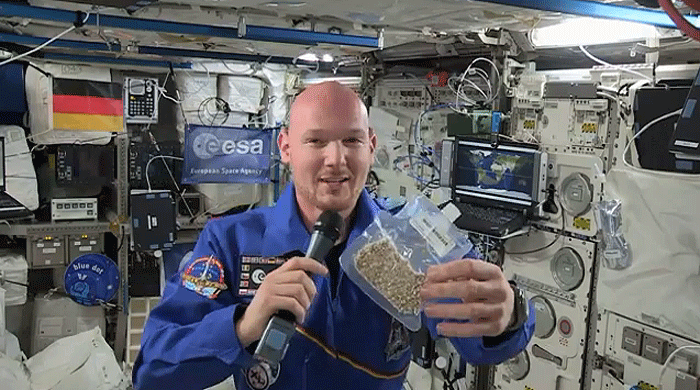

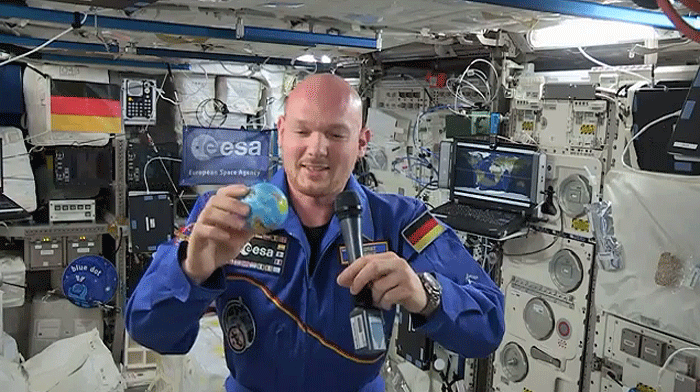
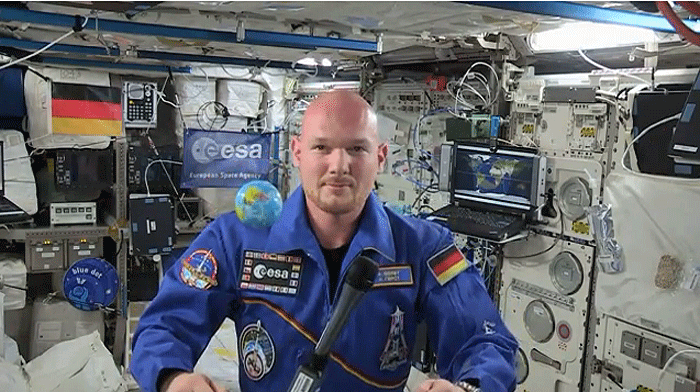

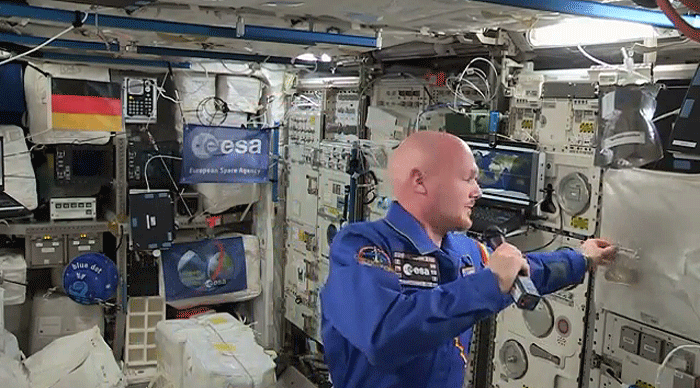
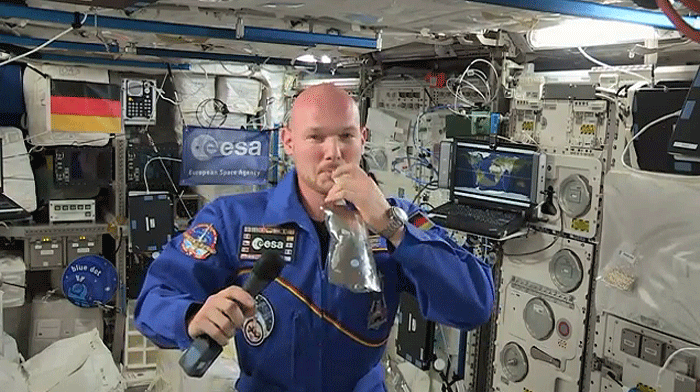
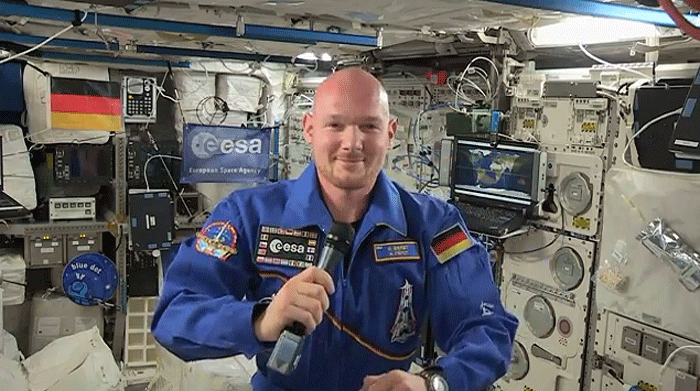
Quelle: NASA
.
Update: 19.09.2014
.
Halbzeit von Blue Dot Mission
.
Halfway through his six-month Blue Dot mission, ESA astronaut Alexander Gerst is sharing the International Space Station with only two colleagues: Maxim Suraev and Reid Wiseman.
The astronauts from Expedition 40 left the orbital outpost last week and landed safely back on Earth. Max, Alexander and Reid will have the Space Station to themselves until the next Soyuz spacecraft arrives on 25 October with NASA astronaut Barry Wilmore and cosmonauts Elena Serova and Alexander Samoukutyaev.
.
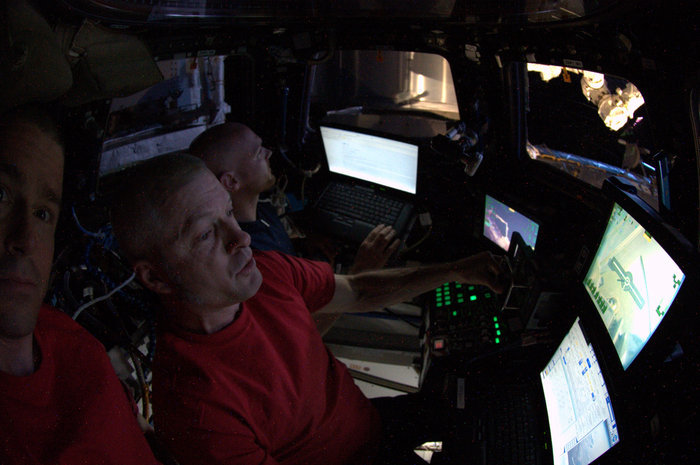
But the research work does not come to a halt during the two weeks the Station has a reduced crew.
On 22 September Alexander and Reid will use the robotic arm to grapple and berth the latest Dragon cargo vessel bringing supplies. They began preparing the WORKSTATION by routing cables and setting up controls in the six-window Cupola observatory. Alexander also collected items for return to Earth on the Dragon ferry.
International science
Alexander and Reid continue to collect inputs for ESA’s Energy experiment that charts precisely how many calories astronauts need in space. The duo took urine and water samples and prepared them for for analysis on Earth.
For Japan’s space agency, JAXA, Alexander worked on experiments on growing semiconductors in microgravity and how animal cells sense gravity.
Alexander continues to use his experience as a VOLUNTEER firefighter for NASA’s experiments burning fuel droplets. The results will improve our understanding of how fires behave in space and help to raise the fuel efficiency of engines on the ground.
Earlier this month, Alexander worked on MagVector, a European experiment investigating how Earth’s MAGNETIC field interacts with electrical conductors. This research will not only help to improve future Space Station experiments and electrical experiments but it could also offer insights into how magnetic fields influence conductors in general – a backbone of terrestrial technology.
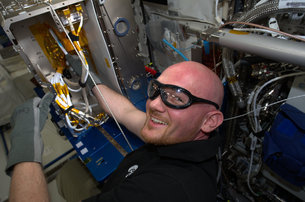
In his spare time, Alexander takes amazing IMAGES of our planet and continues to work on scientific experiments. The large Electromagnetic Levitator arrived at the Station on ESA’s Automated Transfer Vehicle in August but a bolt securing the hardware for launch was stuck. Alexander managed to saw the bolt out, cleverly using SHAVING foam to keep any metal debris from floating free. All in a day’s work for an astronaut.
Quelle: ESA
.
Update: 5.10.2014
.
ESA astronaut Alexander Gerst has spent four months in the relative safety of the International Space Station but on Tuesday he will venture into open space with NASA astronaut Reid Wiseman on a seven-hour spacewalk.
Thumbs-up for spacewalkThe spacewalk’s main JOB is to move a failed cooling PUMP that was left in a temporary location by previous spacewalkers to its final position. Alexander and Reid will then install a unit that will allow the Station’s robotic arm to remain powered even when it is being relocated.
Before exiting the Station’s Quest airlock at around 12:10 GMT (14:10 CEST), they will breathe pure oxygen for more than two hours to remove nitrogen from their bodies, much like deep-sea scuba divers do.
The two spacewalkers will work together, independently. To start, Reid will set up the NEW HOME for the pump while Alexander retrieves the unit from further along the Station’s truss. Reid will then begin their second task of installing the arm power unit, stopping at times to refasten Alexander’s tether to let him move around safely.
Thumbs-up for spacewalkThe spacewalk’s main JOB is to move a failed cooling PUMP that was left in a temporary location by previous spacewalkers to its final position. Alexander and Reid will then install a unit that will allow the Station’s robotic arm to remain powered even when it is being relocated.
Before exiting the Station’s Quest airlock at around 12:10 GMT (14:10 CEST), they will breathe pure oxygen for more than two hours to remove nitrogen from their bodies, much like deep-sea scuba divers do.
The two spacewalkers will work together, independently. To start, Reid will set up the NEW HOME for the pump while Alexander retrieves the unit from further along the Station’s truss. Reid will then begin their second task of installing the arm power unit, stopping at times to refasten Alexander’s tether to let him move around safely.
.
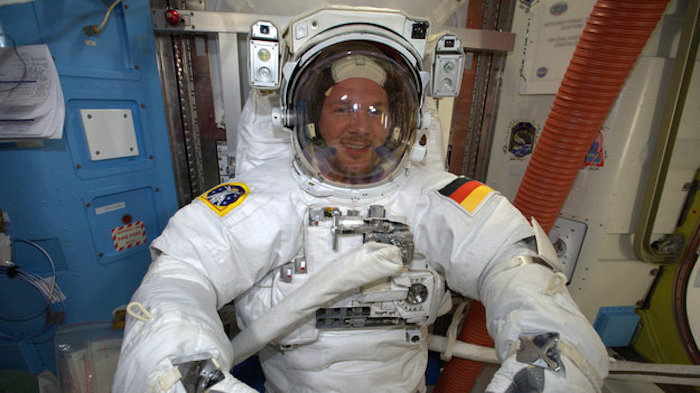
ESA astronaut Alexander Gerst testing his spacesuit on the International Space Station in preparation for 7 October 2014 when he will venture into open space with NASA astronaut Reid Wiseman on a seven-hour spacewalk.
Their main job is to move a failed cooling pump that was left in a temporary location by previous spacewalkers to its final position. Alexander and Reid will then install a unit that will allow the Station’s robotic arm to remain powered even when it is being relocated.
This sortie will be the 27th US-led spacewalk. Reid has the callsign EV1 and will be wearing the suit with red stripes, while Alexander will be EV2 without stripes.
.
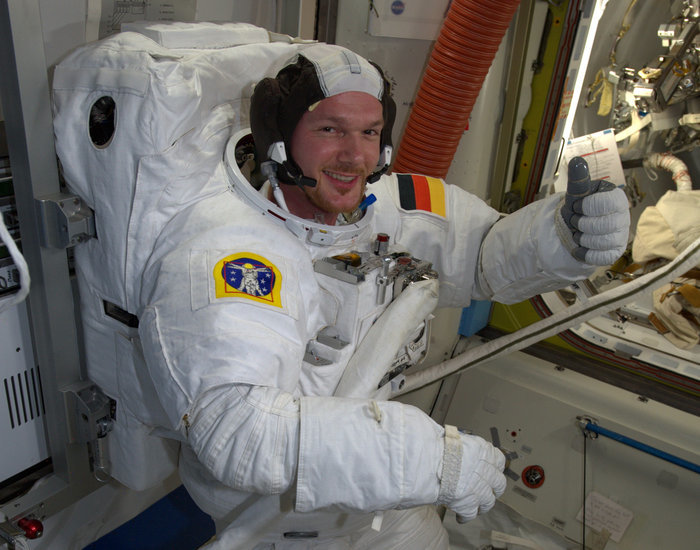
The duo will fix the pump to its final resting place together and then work in unison on the robotic arm.
Spacewalks are carefully choreographed AFFAIRS requiring meticulous planning and perfect coordination between the astronauts and ground control.
ESA’s lead mission director for Space Station Expeditions 41 and 42, Alex Nitsch, is responsible for the European part of Alexander’s Blue Dot mission. Based at the Columbus CONTROL Centre in Oberpfaffenhofen, Germany, Alex notes: “Preparing and rehearsing for a spacewalk takes weeks and involves all the partners at the Station CONTROL centres in Houston, USA and Moscow, Russia.”
Every 90 minutes, the Station completes a full circuit of Earth. Sunlight can be blinding the astronauts one moment, and the next moment they are in darkness with only HELMET lights to illuminate their workplace.
“For ground control and the astronauts, spacewalks are no walk in the park,” continues Alex. “They are tiring and require utmost concentration. From the moment you get out of the door till the time you are back in the airlock, everybody is under a very tight schedule.”
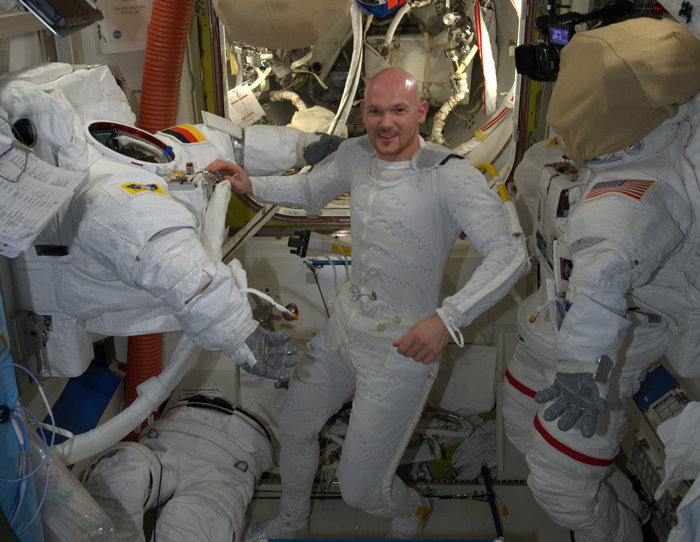
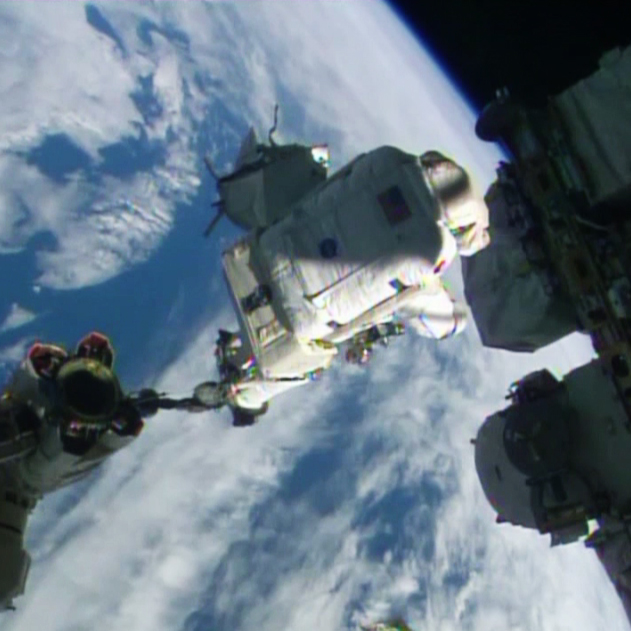
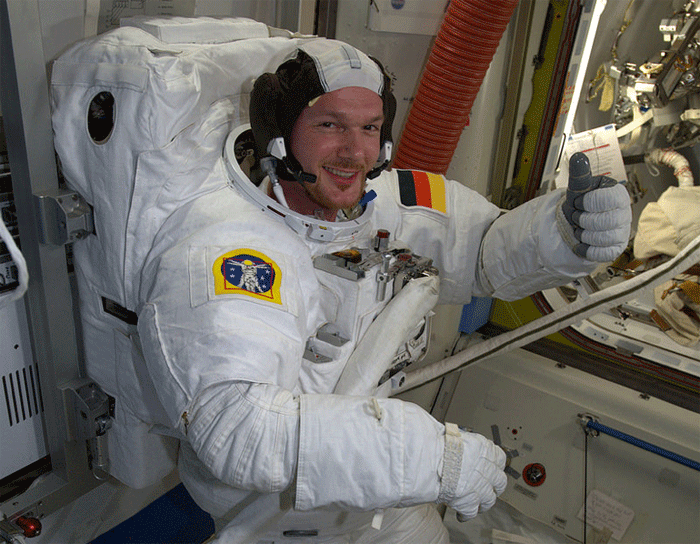
To make the most use of their time outside, the astronauts have a ‘get-ahead’ checklist. If time and energy allows, they will start on JOBSplanned for future spacewalks such as rerouting cables and reconfiguring equipment.
This sortie will be the 27th US-led spacewalk. Reid has the callsign EV1 and will be wearing the SUIT with red stripes, while Alexander will be EV2 without stripes. Follow the spacewalk live via NASA television on 7 October from 11:00 GMT (13:00 CEST).
.

ESA astronaut Alexander Gerst wearing the undergarment for his 7 October 2014 spacewalk. He will venture into open space with NASA astronaut Reid Wiseman on a seven-hour sortie. Reid has the callsign EV1 and will be wearing the SUIT on the right with red stripes, while Alexander will be EV2 and wear the spacesuit without stripes but with a German flag.
Quelle: ESA
.
Update: 7.10.2014
.
Wiseman and Gerst Complete First Spacewalk of Expedition 41
Astronauts Reid Wiseman of NASA and Alexander Gerst of the European Space Agency completed the first of three Expedition 41 spacewalks at 2:43 p.m. EDT Tuesday. The spacewalkers worked outside the Quest airlock of the International Space Station for 6 hours and 13 minutes.
Flight Engineer Barry Wilmore NASA operated the Canadian robotic arm, maneuvered Gerst during the course of the spacewalk and served as the spacewalk coordinator.
The first task for Wiseman and Gerst was relocating a failed cooling pump to External Stowage Platform-2 (ESP-2) just outside the Quest airlock. It was temporarily stowed on the station’s truss by Expedition 38 spacewalkers Mike Hopkins and Rick Mastracchio on Dec. 21 after they replaced the failed pump with a spare.
When they completed the pump module stowage work, the duo stowed adjustable grapple bars on ESP-2. Wiseman cleaned up the work area around the pump module.
Gerst went on to replace a light on an External Television Camera Group (ETVCG) outside Destiny.
The next task was the installation of a Mobile Transporter Relay Assembly (MTRA) on to the S0 truss right above the Destiny laboratory. The MTRA adds the capability to provide “keep-alive” power to the Mobile Servicing System when the Mobile Transporter is moving between worksites.
The Mobile Transporter can move supplies, gear and the Canadarm2 on rails along the Integrated Truss Structure, the station’s backbone. The Mobile Servicing System, which includes the transporter and Canadarm2, plays a key role in station maintenance tasks.
A second U.S. spacewalk is set for Oct. 15. Wilmore will don a U.S. spacesuit and follow Wiseman outside the Quest airlock for a 6-1/2 hour excursion. Gerst will serve as the spacewalk choreographer. The goal of the excursion is to replace a failed voltage regulator component on the starboard truss of the station called a Sequential Shunt Unit that stopped operating in May, taking down one of eight power channels on the station’s electrical system. They will also move external camera equipment in advance of a major reconfiguration of station modules next year for the arrival of new docking adapters for commercial crew vehicles.
The first Russian spacewalk of Expedition 41 is scheduled for Oct. 22. Cosmonauts Alexander Samokutyaev and Max Suraev will wear Russian Orlan spacesuits and exit the Pirs docking compartment at 9:24 a.m. They will remove and jettison an experiment and a pair of antennas as part of their spacewalking schedule.
.

Spacewalker Alexander Gerst rides the Canadarm2 to a work site on the International Space Station.
Image Credit: NASA TV
.
Alexander hat vier Monate in der relativen Sicherheit der Internationalen Raumstation ISS verbracht. Nun wird er am kommenden Dienstag, 7. Oktober 2014, sich in den offenen Weltraum wagen und gemeinsam mit NASA-Astronaut Reid Wiseman einen siebenstündigen Außenbordeinsatz ("EVA - Extra Vehicular Activity") unternehmen.
Hauptaufgabe der beiden Astronauten wird es sein, eine defekte Kühlpumpe, die während eines vorherigen Außenbordeinsatzes anderer Raumfahrer an einem provisorischen Ort angebracht wurde, an ihren finalen Bestimmungsort zu transportieren. Alex und Reid werden danach ein Aggregat installieren, die es erlauben wird, den Roboterarm der Station mit Strom zu versorgen. Selbst dann, wenn der Arm an eine neue Stelle verbracht wird.
Ausstieg um 14:10 MESZ
Bevor die Astronauten die Station durch die Quest-Luftschleuse gegen 12:10 UTC (14:10 MESZ) verlassen, werden sie zwei Stunden lang reinen Sauerstoff atmen, um den Stickstoffanteil im Blut zu reduzieren – ähnlich wie es Tiefseetaucher tun.
Die beiden Astronauten werden gemeinsam arbeiten. Zunächst wird Reid Wiseman den endgültigen Lagerort der Pumpe vorbereiten, während Alex sie von ihrer aktuellen Position abmontieren und herübertransportieren wird. Anschließend wird Wiseman mit der zweiten Aufgabe beginnen, der Installation des Stromaggregats für den Roboterarm.
Das Duo wird die Kühlpumpe an ihrem Bestimmungsort fixieren und anschließend gemeinsam am Roboterarm arbeiten.
.

Cleaned out airlock, packed tool bags and configured our cameras. Space suits are ready.
Luftschleuse ausgeräumt, Werkzeugtaschen gepackt und unsere Kameras konfiguriert. Raumanzüge sind fit.
Credits: ESA/NASA
6165 Views
